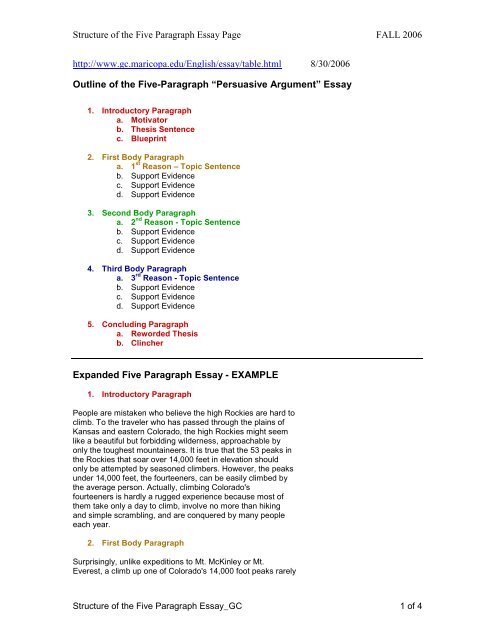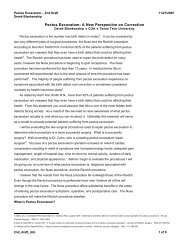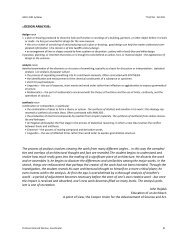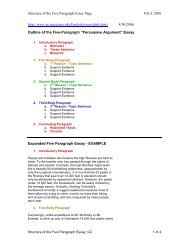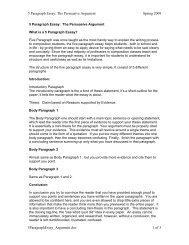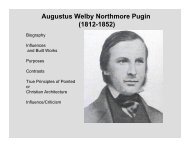Outline of the Five Paragraph Essay
Outline of the Five Paragraph Essay
Outline of the Five Paragraph Essay
You also want an ePaper? Increase the reach of your titles
YUMPU automatically turns print PDFs into web optimized ePapers that Google loves.
Structure <strong>of</strong> <strong>the</strong> <strong>Five</strong> <strong>Paragraph</strong> <strong>Essay</strong> Page FALL 2006<br />
http://www.gc.maricopa.edu/English/essay/table.html 8/30/2006<br />
<strong>Outline</strong> <strong>of</strong> <strong>the</strong> <strong>Five</strong>-<strong>Paragraph</strong> “Persuasive Argument” <strong>Essay</strong><br />
1. Introductory <strong>Paragraph</strong><br />
a. Motivator<br />
b. Thesis Sentence<br />
c. Blueprint<br />
2. First Body <strong>Paragraph</strong><br />
a. 1 st Reason – Topic Sentence<br />
b. Support Evidence<br />
c. Support Evidence<br />
d. Support Evidence<br />
3. Second Body <strong>Paragraph</strong><br />
a. 2 nd Reason - Topic Sentence<br />
b. Support Evidence<br />
c. Support Evidence<br />
d. Support Evidence<br />
4. Third Body <strong>Paragraph</strong><br />
a. 3 rd Reason - Topic Sentence<br />
b. Support Evidence<br />
c. Support Evidence<br />
d. Support Evidence<br />
5. Concluding <strong>Paragraph</strong><br />
a. Reworded Thesis<br />
b. Clincher<br />
Expanded <strong>Five</strong> <strong>Paragraph</strong> <strong>Essay</strong> - EXAMPLE<br />
1. Introductory <strong>Paragraph</strong><br />
People are mistaken who believe <strong>the</strong> high Rockies are hard to<br />
climb. To <strong>the</strong> traveler who has passed through <strong>the</strong> plains <strong>of</strong><br />
Kansas and eastern Colorado, <strong>the</strong> high Rockies might seem<br />
like a beautiful but forbidding wilderness, approachable by<br />
only <strong>the</strong> toughest mountaineers. It is true that <strong>the</strong> 53 peaks in<br />
<strong>the</strong> Rockies that soar over 14,000 feet in elevation should<br />
only be attempted by seasoned climbers. However, <strong>the</strong> peaks<br />
under 14,000 feet, <strong>the</strong> fourteeners, can be easily climbed by<br />
<strong>the</strong> average person. Actually, climbing Colorado's<br />
fourteeners is hardly a rugged experience because most <strong>of</strong><br />
<strong>the</strong>m take only a day to climb, involve no more than hiking<br />
and simple scrambling, and are conquered by many people<br />
each year.<br />
2. First Body <strong>Paragraph</strong><br />
Surprisingly, unlike expeditions to Mt. McKinley or Mt.<br />
Everest, a climb up one <strong>of</strong> Colorado's 14,000 foot peaks rarely<br />
Structure <strong>of</strong> <strong>the</strong> <strong>Five</strong> <strong>Paragraph</strong> <strong>Essay</strong>_GC 1 <strong>of</strong> 4
Structure <strong>of</strong> <strong>the</strong> <strong>Five</strong> <strong>Paragraph</strong> <strong>Essay</strong> Page FALL 2006<br />
takes more than a day. Pike's Peak, with <strong>the</strong> state's greatest<br />
base-to-summit elevation gain, is admittedly a strenuous<br />
climb, yet a retired college pr<strong>of</strong>essor in his middle seventies<br />
makes <strong>the</strong> hike every day in <strong>the</strong> summer. A friend <strong>of</strong> mine,<br />
Carson Black, in a day, once climbed four fourteeners, three<br />
<strong>of</strong> which--Crestone Peak, Crestone Needle, and Kit Carson<br />
Peak--are <strong>the</strong> most challenging in <strong>the</strong> state. Even more<br />
revealing is <strong>the</strong> Bicentennial celebration by <strong>the</strong> Colorado<br />
Mountain Club. It planned to have members on <strong>the</strong> summit <strong>of</strong><br />
every fourteener in <strong>the</strong> state on July 4, 1976. Only a handful<br />
<strong>of</strong> ascents took more than a day.<br />
3. Second Body <strong>Paragraph</strong><br />
Colorado's 14,000-foot peaks are also fairly easy to climb<br />
because <strong>the</strong>y require no special climbing techniques. The<br />
"knife-edge traverse" on Capitol Peak is probably <strong>the</strong> most<br />
infamous challenge, yet most hikers who carry ropes don't<br />
use <strong>the</strong>m when <strong>the</strong>y see <strong>the</strong> ridge is not very intimidating.<br />
The highest peak in <strong>the</strong> state, Mt. Elbert, is so simple to climb<br />
that a jeep made it in 1949, and one man "rode a 24-year-old<br />
bicycle to <strong>the</strong> summit in 1951" (Perry Eberhart and Philip<br />
Schmuck, The Fourteeners, p. 38). I personally saw two<br />
motorcycles on <strong>the</strong> 14,000-foot ridge between Mt. Democrat and Mt. Lincoln.<br />
4. Third Body <strong>Paragraph</strong><br />
Ano<strong>the</strong>r indication that climbing Colorado's highest peaks is<br />
not very difficult is <strong>the</strong> sheer number <strong>of</strong> people who succeed<br />
each summer. After descending from Torrey's Peak one<br />
weekend in August, I counted over seventy cars in <strong>the</strong><br />
parking lot. On a week <strong>the</strong> previous August, I passed fifty<br />
people in various stages <strong>of</strong> climbing Mt. Elbert. Even years<br />
ago--in 1968--4226 people climbed Longs Peak (Paul W.<br />
Nesbit, Longs Peak, p. 68). Its parking lot today, to<br />
accommodate <strong>the</strong> number <strong>of</strong> climbers, is about a quarter-mile<br />
long.<br />
5. Concluding <strong>Paragraph</strong><br />
If I've shattered your belief that Colorado's peaks are <strong>the</strong> domain <strong>of</strong> only bears and mountain men<br />
who look like bears, consider how Zebulon Pike might feel about Pikes Peak today. In 1806, he<br />
"predicted that <strong>the</strong> mountain would never be climbed" (Eberhart and Schmuck, p. 6). Now, via <strong>the</strong><br />
cog railway or <strong>the</strong> toll highway, he could reach <strong>the</strong> summit without moving his legs.<br />
Structure <strong>of</strong> an Introductory <strong>Paragraph</strong><br />
Motivator: People are mistaken who believe <strong>the</strong> high Rockies are hard to<br />
climb.<br />
Thesis: Climbing Colorado's fourteeners is hardly a rugged<br />
experience...<br />
Blueprint: ...most <strong>of</strong> <strong>the</strong>m take only a day to climb, involve only hiking<br />
and simple scrambling, and are conquered by many people<br />
every year.<br />
Structure <strong>of</strong> <strong>the</strong> <strong>Five</strong> <strong>Paragraph</strong> <strong>Essay</strong>_GC 2 <strong>of</strong> 4
Structure <strong>of</strong> <strong>the</strong> <strong>Five</strong> <strong>Paragraph</strong> <strong>Essay</strong> Page FALL 2006<br />
Introductory <strong>Paragraph</strong><br />
People are mistaken who believe <strong>the</strong> high Rockies are hard to climb. To <strong>the</strong><br />
traveler who has passed through <strong>the</strong> plains <strong>of</strong> Kansas and eastern Colorado, <strong>the</strong><br />
high Rockies might seem like a beautiful but forbidding wilderness,<br />
approachable by only <strong>the</strong> toughest mountaineers. It is true that <strong>the</strong> 53 peaks in<br />
<strong>the</strong> Rockies that soar over 14,000 feet in elevation should only be attempted by<br />
seasoned climbers. However, <strong>the</strong> peaks under 14,000 feet, <strong>the</strong> fourteeners, can<br />
be easily climbed by <strong>the</strong> average person. Actually, climbing Colorado's<br />
fourteeners is hardly a rugged experience because most <strong>of</strong> <strong>the</strong>m take only a day<br />
to climb, involve no more than hiking and simple scrambling, and are conquered<br />
by many people each year.<br />
First Body <strong>Paragraph</strong><br />
Topic Sentence A climb up one <strong>of</strong> Colorado's 14,000 foot peaks rarely<br />
more than a day.<br />
Support Evidence Old pr<strong>of</strong>essor makes daily climbs.<br />
Support Evidence A friend climbed four in one day.<br />
Support Evidence Colorado Mountain Club climbed most <strong>of</strong> <strong>the</strong> state's<br />
fourteeners in a day to celebrate <strong>the</strong> Bicentennial.<br />
Surprisingly, unlike expeditions to Mt. McKinley or Mt. Everest, a climb up one <strong>of</strong><br />
Colorado's 14,000 foot peaks rarely takes more than a day. Pike's Peak, with <strong>the</strong><br />
state's greatest base-to-summit elevation gain, is admittedly a strenuous climb,<br />
yet a retired college pr<strong>of</strong>essor in his middle seventies makes <strong>the</strong> hike every day<br />
in <strong>the</strong> summer. A friend <strong>of</strong> mine, Carson Black, in a day, once climbed four<br />
fourteeners, three <strong>of</strong> which--Crestone Peak, Crestone Needle, and Kit Carson<br />
Peak--are <strong>the</strong> most challenging in <strong>the</strong> state. Even more revealing is <strong>the</strong><br />
Bicentennial celebration by <strong>the</strong> Colorado Mountain Club. It planned to have<br />
members on <strong>the</strong> summit <strong>of</strong> every fourteener in <strong>the</strong> state on July 4, 1976. Only a<br />
handful <strong>of</strong> ascents took more than a day.<br />
Structure <strong>of</strong> <strong>the</strong> <strong>Five</strong> <strong>Paragraph</strong> <strong>Essay</strong>_GC 3 <strong>of</strong> 4
Structure <strong>of</strong> <strong>the</strong> <strong>Five</strong> <strong>Paragraph</strong> <strong>Essay</strong> Page FALL 2006<br />
Second Body <strong>Paragraph</strong><br />
Topic Sentence Colorado's 14,000-foot peaks are easy to climb.<br />
Support EvidenceThe "knife-edge traverse" on Capitol Peak is a challen<br />
ropes aren't usually used.<br />
Support EvidenceThe highest peak in <strong>the</strong> state, Mt. Elbert, is simple to c<br />
Support EvidenceI personally saw two motorcycles on <strong>the</strong> 14,000-foot ri<br />
Colorado's 14,000-foot peaks are also fairly easy to climb because <strong>the</strong>y require<br />
no special climbing techniques. The "knife-edge traverse" on Capitol Peak is<br />
probably <strong>the</strong> most infamous challenge, yet most hikers who carry ropes don't<br />
use <strong>the</strong>m when <strong>the</strong>y see <strong>the</strong> ridge is not very intimidating. The highest peak in<br />
<strong>the</strong> state, Mt. Elbert, is so simple to climb that a jeep made it in 1949, and one<br />
man "rode a 24-year-old bicycle to <strong>the</strong> summit in 1951" (Perry Eberhart and<br />
Philip Schmuck, The Fourteeners, p. 38). I personally saw two motorcycles on<br />
<strong>the</strong> 14,000-foot ridge between Mt. Democrat and Mt. Lincoln.<br />
Third Body <strong>Paragraph</strong><br />
Topic Sentence Many climb peaks each year.<br />
Support EvidenceI saw over seventy cars in <strong>the</strong> parking lot<strong>of</strong> Torrey's P<br />
Support EvidenceI passed fifty people climbing Mt. Elbert.<br />
Support EvidenceIn 1968, 4226 people climbed Longs Peak.<br />
Ano<strong>the</strong>r indication that climbing Colorado's highest peaks is not very difficult is<br />
<strong>the</strong> sheer number <strong>of</strong> people who succeed each summer. After descending from<br />
Torrey's Peak one weekend in August, I counted over seventy cars in <strong>the</strong><br />
parking lot. On a week <strong>the</strong> previous August, I passed fifty people in various<br />
stages <strong>of</strong> climbing Mt. Elbert. Even years ago--in 1968--4226 people climbed<br />
Longs Peak (Paul W. Nesbit, Longs Peak, p. 68). Its parking lot today, to<br />
accommodate <strong>the</strong> number <strong>of</strong> climbers, is about a quarter-mile long.<br />
Concluding <strong>Paragraph</strong><br />
Reworded Thesis: I've probably shattered your belief that Colorado's pea<br />
<strong>the</strong> domain <strong>of</strong> only bears and mountain men who look<br />
bears<br />
Clincher: Zebulon Pike would be surprised today.<br />
If I've shattered your belief that Colorado's peaks are <strong>the</strong> domain <strong>of</strong> only bears<br />
and mountain men who look like bears, consider how Zebulon Pike might feel<br />
about Pikes Peak today. In 1806, he "predicted that <strong>the</strong> mountain would never<br />
be climbed" (Eberhart and Schmuck, p. 6). Now, via <strong>the</strong> cog railway or <strong>the</strong> toll<br />
highway, he could reach <strong>the</strong> summit without moving his legs.<br />
Structure <strong>of</strong> <strong>the</strong> <strong>Five</strong> <strong>Paragraph</strong> <strong>Essay</strong>_GC 4 <strong>of</strong> 4
ARCH 3501 Architecture Design 4 Fall 2010<br />
Wind Museum Design Argument: Assignment #04<br />
1. Formulate three reasons why your Wind Museum design meets <strong>the</strong>se three<br />
grading criteria – Quality Composition, Tectonic Design, and Programmatically<br />
Responsive. Formulate one reason per criteria.<br />
2. For each Reason identify three design responses in your design which provides<br />
supporting Evidence for <strong>the</strong> Reason.<br />
3. Develop from your Reasons and Evidence a Thesis statement (claim) why your<br />
Wind Museum is good architectural solution.<br />
4. Write a 5 paragraph Persuasive Argument, using <strong>the</strong> handout “5 <strong>Paragraph</strong><br />
<strong>Essay</strong>: The Persuasive Argument” posted on <strong>the</strong> course website.<br />
5. Submit <strong>the</strong> outline below to your instructor.<br />
6. Write a Persuasive Design Argument based on your design.<br />
7. You will be required to read to <strong>the</strong> class your argument during <strong>the</strong> presentation.<br />
1) Introduction – <strong>Paragraph</strong> 1<br />
a) Motivator<br />
b) Thesis<br />
c) Three Reasons - Blueprint<br />
d) Transition<br />
2) Reason 1 – <strong>Paragraph</strong> 2<br />
a) Topic Sentence – Reason 1<br />
b) Evidence 1<br />
c) Evidence 2<br />
d) Evidence 3<br />
3) Reason 2 – <strong>Paragraph</strong> 3<br />
a) Topic Sentence – Reason 2<br />
b) Evidence 1<br />
c) Evidence 2<br />
d) Evidence 3<br />
4) Reason 3 – <strong>Paragraph</strong> 4<br />
a) Topic Sentence – Reason 2<br />
b) Evidence 1<br />
c) Evidence 2<br />
d) Evidence 3<br />
5) Conclusion – <strong>Paragraph</strong> 5<br />
a) Reworded Thesis.<br />
b) Clincher Closing.<br />
WindMuseumDesignArgument20oct10 1


